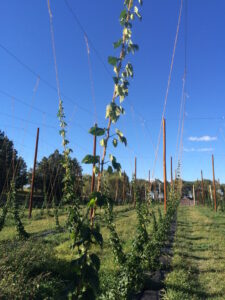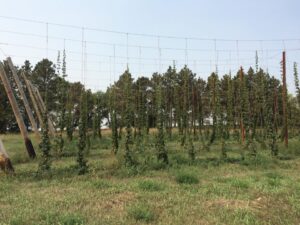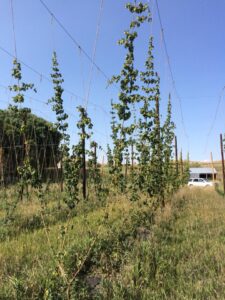Final report for FNC16-1036
Project Information
I run two half acre test plots of hops, and will be adding an additional acre this spring (2018). I also own cattle which I raise in partnership with my father. We work very hard to manage our pastures and meadows by rotating the herd frequently, moving salt boxes to reduce erosion, etc.

I installed two hops trellises in different soil types, sandy and loamy, to ascertain with soil type is superior for hops production. I also planted eight different varieties, again to determine what kind of hops grow best here. To determine the results, I weighed the harvested cones and had the oil content measured by a lab. I then compared the results.
Unfortunately, I had a late frost in the end of May at the time the bines where ready to be trained to the twine. This frost set the plants back a month. Due to this, the harvest was small and oil contents were impacted. Thus, the results of this inquiry must be interpreted with this in mind.
Despite this setback, I did learn much from this experiment. I found that Cascade, Centennial, and Triple Perle, and Chinook hops were the most productive of the varieties; in that order. These varieties are American hybrids and produce more pounds than aromatic varieties. However, even with this considered, these hybrids did outperform the other varieties.
In regards to soil type, all varieties produced better at the sandy plot than the loamy soil plot, except for one variety, Triple Perle. I predict that this is due to the better drainage of the sand. While hops do require approximately a gallon of water per plant per day, the roots do not like to sit in overly saturated soil. Hops growers refer to this as "hops don't like wet feet". Aside from this generalization, it is interesting that the Triple Perle did much better at the loamy soil plot. I have no theories to explain this, I am assuming that this newly developed hops varietal just simply grows better in loamy soil. While all oil contents were low, the Chinook was higher at the loamy plot.
With this information, I have decided to plant Chinook in sandy soil for my next acre. While other varieties did perform marginally better, my brewers have expressed a higher desire for Chinook than the other American hybrids I am currently producing. I am hoping I have better weather this coming season and can obtain more robust data for comparison. My plants will be fully mature and I am hoping the aromatics perform better given that they are worth more per pound. While planting my next acre with Chinook that I know performs well, I have not dismissed the possibility of raising aromatics.
My objective for this project was to examine the difference in hops production of different varieties in two different soil types. The varieties of hops planted are: Cascade, Cashmere, Chinook, Centennial, Triple Perle, Nugget, Yakima Gold, and Hallertauer. I planted these in two test plots, in sandy and loamy soil. I will use the results of the productivity of these plots to assist me in making decisions on new plot placement and varieties planted. I will distribute this information to other potential and established hops farmers through the iGrow website and the South Dakota Hops Growers Association. I believe that hops farming in South Dakota is an opportunity for more people to enter agriculture, or diversity their current operations on a relatively small amount of acreage. Brewers in the state will also benefit by being able to produce and market a locally sourced beer.
Research
I installed two hops plots. One was planted in a heavier clay soil (Martin plot), and the other in sandier soil (cabin plot). Soil tests were obtained from both locations. I prepared the hops mounds by digging holes with an auger, and refilling the hole with the original soil and added compost. I then installed the poles and cabling. My trellis systems are 16 foot tall and contain almost 700 hops plants. I utilized landscape fabric and drip line irrigation. Eight varieties were planted: Cascade, Centennial, Chinook, Cashmere, Triple Perle, Yakima Gold, Hallertaur, and Nugget. Once the plants grew to one foot, I trained them to coconut coir twine. Once the fields where installed, I monitored the irrigation, fertilized, and scouted for insects.
The harvest for 2017 was difficult. Usually the hops are ready to harvest when the cones naturally reach a dry matter of around 25%. Scent is also utilized to determine crop readiness. The hops should not smell grassy, indicating the they are not yet ready. Nor should they smell like onion or garlic, indicating that they are over ripe. My plants were harvested at 28-37% dry matter as some of the cones where beginning to smell over-ripe. I believe that because of the frost the plants were behind in growth, but the shortening days of fall caused the oils to mature on schedule.
To measure any variance in productivity, I measured the weight of harvested hops and sent a sample from each of the 16 test units for alpha acid, beta acid content, and storage index analysis. I will repeat this process annually as the plants become better established and more productive.
I weighed the harvested cones and sent samples for chemical analysis. The most important result is the chemical analysis. The hops cones are worthless if they do not contain adequate levels of alpha and beta acids. Once I determine which varieties do produce these levels, then the secondary result of harvested weight will be considered. Hops are sold by the pound or ounce, so harvested weight is important to ascertain as well.
Because of a late frost, my harvest was very small. Despite this, I was able to harvest and collect data. The results are displayed in the attached spreadsheet. I am hoping for better weather next season so that more robust data can be obtained. Harvest-Data-2017-SARE
Educational & Outreach Activities
Participation Summary:
To share the information I learned from this project I am submitting a report to Christopher Graham, the South Dakota State University Extension Agronomist. He can post my findings on the iGrow website or give it directly to other farmers interested in growing hops.
I will also share my findings with my fellow members of the developing South Dakota Hops Growers Association and our partner, the South Dakota Speciality Producers Association.
Learning Outcomes
Like all farming, we are at the mercy of the weather and seasonal fluctuations. Due to a late freeze in 2017, I did not have a good harvest and my results must be interpreted with this extra stress in mind. However, despite this obstacle I have learned much from comparing the performance of eight varieties in two test plots. These results have helped me in deciding where to place my next plot, and what to plant in it. While I don't have the data to support it, I do believe the performance of my plants support that hops farming is possible in Southwest South Dakota. I would recommend to other farmers considering growing hops to start small and to grow at least one American hybrid variety.

 Hines_FNC16-1036Budgetok
Hines_FNC16-1036Budgetok